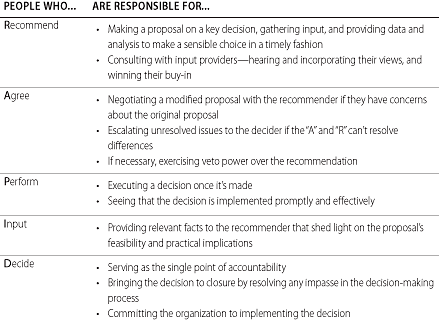Decisions are the coin of the realm in business. Every success, every mishap, every opportunity seized or missed stems from a decision someone made-or failed to make. Yet in many firms, decisions routinely stall inside the organization-hurting the entire company's performance.
The culprit? Ambiguity over who's accountable for which decisions. In one auto manufacturer that was missing milestones for rolling out new models, marketers and product developers each thought they were responsible for deciding new models' standard features and colors. Result? Conflict over who had final say, endless revisiting of decisions-and missed deadlines that led to lost sales.
How to clarify decision accountability? Assign clear roles for the decisions that most affect your firm's performance-such as which markets to enter, where to allocate capital, and how to drive product innovation. Think "RAPID": Who should recommend a course of action on a key decision? Who must agree to a recommendation before it can move forward? Who will perform the actions needed to implement the decision? Whose input is needed to determine the proposal's feasibility? Who decides-brings the decision to closure and commits the organization to implement it?
When you clarify decision roles, you make the right choices-swiftly and effectively.
The Idea in Practice
The RAPID Decision Model
For every strategic decision, assign the following roles and responsibilities:

Decision-Role Pitfalls
In assigning decision roles:
- Ensure that only one person "has the D." If two or more people think they're in charge of a particular decision, a tug-of-war results.
- Watch for a proliferation of "A's." Too many people with veto power can paralyze recommenders. If many people must agree, you probably haven't pushed decisions down far enough in your organization.
- Avoid assigning too many "I's." When many people give input, at least some of them aren't making meaningful contributions.
The RAPID Model in Action
Decisions are the coin of the realm in business. Every success, every mishap, every opportunity seized or missed is the result of a decision that someone made or failed to make. At many companies, decisions routinely get stuck inside the organization like loose change. But it's more than loose change that's at stake, of course; it's the performance of the entire organization. Never mind what industry you're in, how big and well known your company may be, or how clever your strategy is. If you can't make the right decisions quickly and effectively, and execute those decisions consistently, your business will lose ground.
Indeed, making good decisions and making them happen quickly are the hallmarks of high-performing organizations. When we surveyed executives at 350 global companies about their organizational effectiveness, only 15% said that they have an organization that helps the business outperform competitors. What sets those top performers apart is the quality, speed, and execution of their decision making. The most effective organizations score well on the major strategic decisions-which markets to enter or exit, which businesses to buy or sell, where to allocate capital and talent. But they truly shine when it comes to the critical operating decisions requiring consistency and speed-how to drive product innovation, the best way to position brands, how to manage channel partners.
Even in companies respected for their decisiveness, however, there can be ambiguity over who is accountable for which decisions. As a result, the entire decision-making process can stall, usually at one of four bottlenecks: global versus local, center versus business unit, function versus function, and inside versus outside partners.
The first of these bottlenecks, global versus local decision making, can occur in nearly every major business process and function. Decisions about brand building and product development frequently get snared here, when companies wrestle over how much authority local businesses should have to tailor products for their markets. Marketing is another classic global versus local issue-should local markets have the power to determine pricing and advertising?
The second bottleneck, center versus business unit decision making, tends to afflict parent companies and their subsidiaries. Business units are on the front line, close to the customer; the center sees the big picture, sets broad goals, and keeps the organization focused on winning. Where should the decision-making power lie? Should a major capital investment, for example, depend on the approval of the business unit that will own it, or should headquarters make the final call?
Function versus function decision making is perhaps the most common bottleneck. Every manufacturer, for instance, faces a balancing act between product development and marketing during the design of a new product. Who should decide what? Cross-functional decisions too often result in ineffective compromise solutions, which frequently need to be revisited because the right people were not involved at the outset.
The fourth decision-making bottleneck, inside versus outside partners, has become familiar with the rise of outsourcing, joint ventures, strategic alliances, and franchising. In such arrangements, companies need to be absolutely clear about which decisions can be owned by the external partner (usually those about the execution of strategy) and which must continue to be made internally (decisions about the strategy itself). In the case of outsourcing, for instance, brand-name apparel and foot-wear marketers once assumed that overseas suppliers could be responsible for decisions about plant employees' wages and working conditions. Big mistake.
Clearing the Bottlenecks
The most important step in unclogging decision-making bottlenecks is assigning clear roles and responsibilities. Good decision makers recognize which decisions really matter to performance. They think through who should recommend a particular path, who needs to agree, who should have input, who has ultimate responsibility for making the decision, and who is accountable for follow-through. They make the process routine. The result: better coordination and quicker response times.
 The Successful Leader (Part II) Page 8 Page 10
The Successful Leader (Part II) Page 8 Page 10